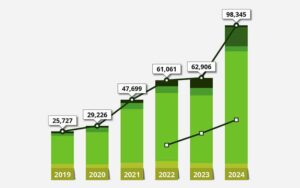Improved cold chain could halve food waste
29th May 2024
USA: Improved refrigeration could save nearly half of the 1.3 billion tons of food wasted each year globally, a new report insists.
The new study by the University of Michigan finds that nearly half of the food waste, about 620 million tonnes, could be eliminated by fully refrigerated food supply chains worldwide.
At the same time, fully refrigerated supply chains could cut food waste-related emissions of climate-warming greenhouse gases by 41% globally, according to the study published in the peer-reviewed journal Environmental Research Letters.
About a third of the food produced globally each year goes to waste, while approximately 800 million people suffer from hunger, according to the UN’s Food and Agriculture Organisation. In many situations, developing more localised, less industrialised “farm-to-table” food supply chains may yield food savings comparable to optimised cold chains, according to the study.
Sub-Saharan Africa and south and southeast Asia have the greatest potential for reductions in both food losses and related emissions through increased cold-chain implementation, according to the study.
South and southeast Asia could see a 45% reduction in food losses and a 54% decrease in associated emissions under an optimised refrigeration scenario. Sub-Saharan Africa has tremendous opportunities for both food loss (47%) and emissions (66%) reductions under optimised refrigeration conditions, the study shows.


The new University of Michigan study, which was part-funded by Carrier Global, focuses on food losses in the post-harvest to retail stages of the food supply chain and does not address on-farm or at-home losses.
The study accounts for the greenhouse gases emitted during food production. It does not include emissions tied to refrigeration or other supply-chain operations and does not include emissions from food waste in landfills.
The study found that the greatest opportunity to improve food losses in less industrialised economies is the supply chain between the farm and the consumer. In North America, Europe and other more industrialised regions, most food loss happens at the household level.
The study found that meat accounts for more than 50% of food loss-related greenhouse gas emissions, despite accounting for less than 10% of global food losses by weight. Optimised refrigeration of meat could result in the elimination of more than 43% of emissions associated with meat loss, the study maintains.
Unlike previous studies of this topic, the University of Michigan researchers compared the benefits of globalised, technologically advanced food-supply chains with those of localised “farm-to-table” food systems.
“Hyper-localised food systems resulted in lower food losses than optimised global, refrigerated supply chains,” said lead author Aaron Friedman-Heiman, a master’s student at the university’s School for Environment and Sustainability and Ross School of Business. “The results help quantify the value of maintaining and supporting local food chains.”
For the study, the researchers built a food-loss estimation tool to assess how improved access to the cold chain could impact food loss and its associated greenhouse gas emissions for seven food types in seven regions. They used data from the UN Food and Agriculture Organisation and other sources.
By modelling food losses at each stage of the supply chain, the study highlights where the cold chain can be optimised to reduce food losses and emissions. The researchers analysed the effects of moving from the current state of inconsistent and variable-quality cold chains throughout the world to an optimised system, defined as one with high-quality refrigeration across all stages.
The study estimates that poor cold-chain infrastructure could be responsible for up to 620 million metric tons of global food loss annually, resulting in emissions of 1.8 billion tons of carbon dioxide equivalents, the equivalent of 28% of US annual greenhouse gas emissions.
The researchers say their adaptable, easy-to-use tool will be of use to anyone involved in the food supply chain, including farmers, grocery retailers, government officials and nongovernmental organisations.







